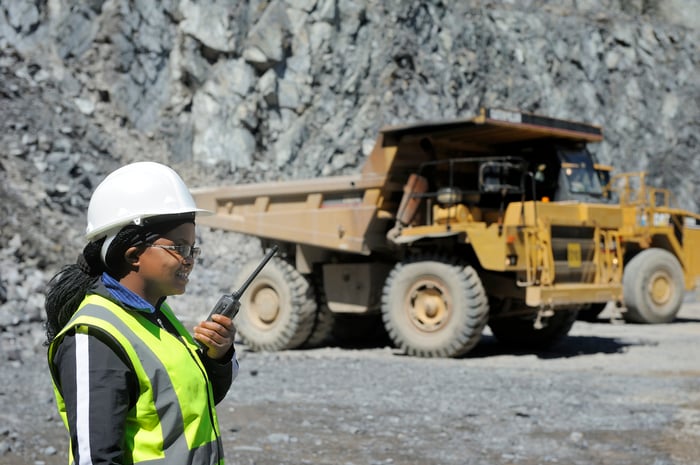Caterpillar's (CAT -0.01%) 2021 is probably best described as a rebound year. That's left it entering 2022 in a strong position, and the company is offering a generous 2.2% dividend yield, which is well above the S&P 500 Index's 1.3% yield. But how safe is this dividend? Here's a quick look at some key numbers.
A great year
Caterpillar had revenue of $51 billion in 2021, up a huge 22% from 2020, when the top line came in at $41.7 billion. Adjusted earnings last year were $10.81 per share, up from $6.56 in 2020. That's a pretty nice improvement, and the company's operating profit margin improved to 13.5% in 2021 from 10.9% the prior year, despite the inflationary headwinds this heavy equipment maker faced.

Image source: Getty Images.
That's all good news, but the big story here is really about the pandemic. When the coronavirus was upending the world in 2020 everything slowed down, including the sale of heavy equipment. Caterpillar's customers, like those of most companies, went into a defensive state, buying only what needed to be purchased and deferring whatever costs could be put off. To put some numbers on that, sales in 2020 were down 22% compared to 2019, with its adjusted earnings of $6.56 per share off from the $11.40 it earned in 2019. In other words, it doesn't pay to read too much into 2021's numbers. However, it does highlight an important fact about Caterpillar.
The company is highly cyclical, with economic ups and down having a material impact on its top and bottom lines. If a dividend investor buys Caterpillar, they need to fully understand that good times will be followed by hard times. It's just how the company works. The pandemic was an unusual event for sure, but it really highlighted this fact.
So how robust is Caterpillar's dividend, given that it has to withstand the impact of economic cycles?
The dividend
One of the first things that will stand out here is Caterpillar's commitment to its dividend. The company is a Dividend Aristocrat, with 28 consecutive years of annual dividend increases under its belt. That period includes multiple recessions, so the board of directors clearly believes the dividend is important to maintain, and grow, even in the face of adversity.
CAT Dividend Per Share (Quarterly) data by YCharts
There's a nuance here. In 2020 the quarterly dividend was not actually increased. However, because the company did increase its dividend in the middle of 2019, the full-year dividend was higher in 2020 than it was in 2019. With the increase in mid-2021, meanwhile, the full-year dividend in 2021 was higher than the full-year dividend in 2020. So the annual streak was maintained even though Caterpillar played it safe and held the quarterly payout static for eight quarters. While this is a timing issue, it's notable because it gives the company extra time to deal with the cyclicality that is inherent in its business.
Then there's the company's payout ratio, which is currently around 40%. But given the cyclical nature of the company, this figure can vary greatly. In fact, in just the past decade there have been a couple of years in which Caterpillar's earnings didn't cover its dividend. That's why the board's commitment to the dividend is important to note. When the economy hits the skids, it is very possible that this will happen again.
That leads to the importance of looking at the company's balance sheet. Caterpillar's debt-to-equity ratio is around 2.3 today. While that may seem high, Caterpillar has a finance arm that assists buyers given the high cost of its equipment. It's operational debt is fairly modest. And, still, that 2.3 times is toward the lower side of its historical range -- the debt-to-equity ratio rose to nearly 6 during the deep 2007-to-2009 recession. The dividend was maintained through that difficult period, and the company's willingness to lean on its balance sheet was a big piece of that. Given that history it appears to have ample room on the balance sheet to lean on it again if it should need to.
The big picture
Right now, highly cyclical Caterpillar's dividend looks very safe, and it is doing fairly well given the rebounding economy. If you are trying to ascertain how safe the dividend is over the long term, this isn't the year to examine. You need to step back and look at what has happened during periods when the company hasn't been performing well. That's when the board's clear commitment to the dividend becomes vital, given that it has proven willing to support it during economic downturns by relying more heavily on its balance sheet. And, today, it looks like the balance sheet is in strong enough shape to withstand another cyclical blow in stride.
While long-term investors might want to wait for a downturn to actually buy this cyclical name, the dividend does look safe today and, given the history, it should remain so even when Caterpillar's business hits the next rough patch.






